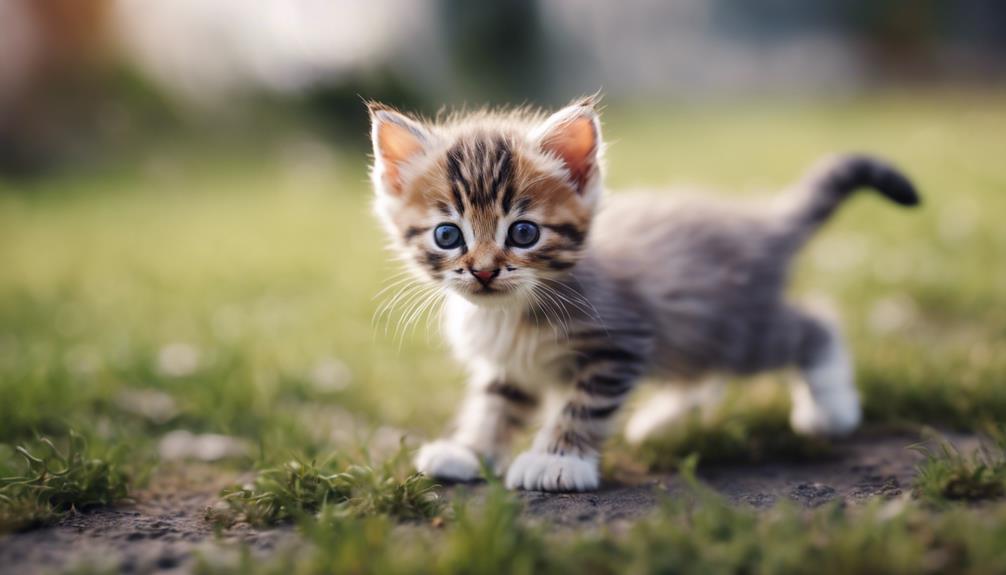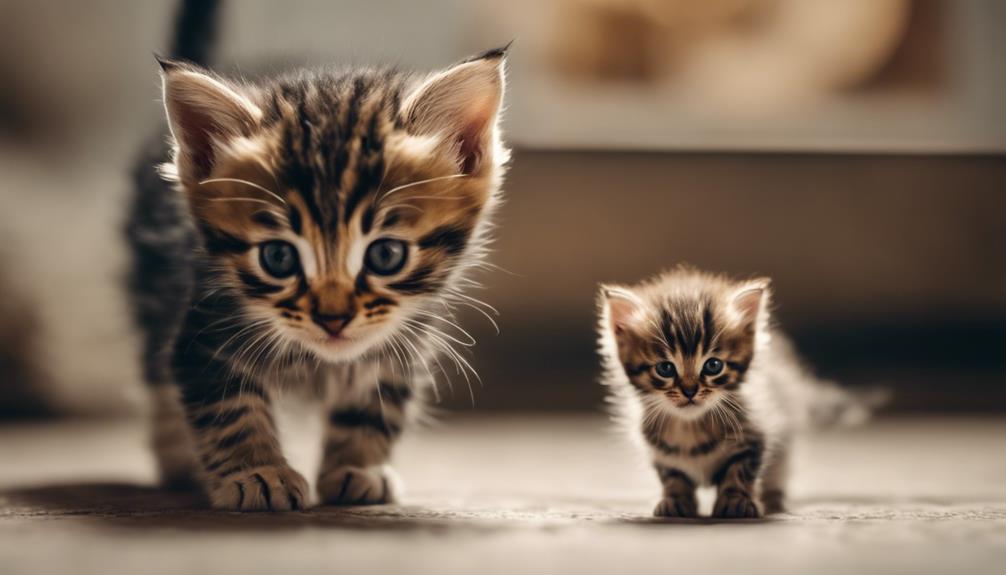As pet owners, witnessing the gradual transition of kittens from crawling to walking marks a pivotal moment in their early development. Understanding the intricate steps involved in this process not only sheds light on the physical abilities of our feline companions but also offers insights into their cognitive growth.
From the tentative first movements to the eventual confident scampering, each stage holds significance in shaping a kitten's mobility skills. Exploring the timeline of when kittens start walking provides a glimpse into the fascinating journey of their early life, offering a deeper understanding of their evolving capabilities.
Key Takeaways
- Kittens typically start walking around 28 days old, progressing from crawling to confident scampering.
- Delayed walking may signal underlying medical issues like nerve damage or metabolic disorders.
- Early vet checks can identify potential walking problems before kittens start exploring.
- Kittens develop their unique walking style as they gain coordination and confidence in their movements.
Early Development: Crawling and Eye Opening
During the early stages of their development, kittens typically begin crawling and open their eyes within the first two weeks of life. At this point, their eyes are still adjusting, and their vision is blurry.
The process of eye opening is gradual, with kittens initially squinting due to sensitivity to light. They rely heavily on their sense of touch and smell during this stage. As they crawl around, their coordination is limited, and they may appear wobbly.
Care should be taken to provide a safe and warm environment for these tiny creatures. This period is crucial for bonding with their mother and littermates, as well as for receiving proper nutrition and warmth to support their growth and development.
Visual Acuity: From Blurry to Clear
As kittens progress in their development, their visual acuity transitions from initially being blurry to eventually becoming clear, enabling them to navigate their surroundings more effectively.
At birth, kittens' vision is limited, with their eyes closed and their visual perception being fuzzy. Within the first week or so, their eyes begin to open, allowing light to enter and stimulating the development of their visual acuity.
Over time, as the muscles controlling their eye movements strengthen and their brain processes visual information more efficiently, kittens' vision becomes sharper and more focused.
This progression from blurry to clear vision is crucial for kittens as they start to explore their environment, interact with their littermates, and eventually learn to walk and play confidently.
Walking Milestone: Around 28 Days

Around the age of 28 days, most kittens are expected to achieve the milestone of walking independently. This marks a significant step in their development, showcasing their growing strength and coordination. As kittens embark on this new journey of mobility, here are some key points to keep in mind:
- Steady Progress: At this stage, kittens may still appear a bit wobbly, but their strides will become more confident as they practice.
- Exploration Begins: Walking enables kittens to explore their surroundings more actively, leading to increased curiosity and playfulness.
- Building Confidence: With each successful step, kittens gain confidence in their abilities, setting the stage for further physical and cognitive growth.
Coordination and Exploration
In the early stages of walking development, kittens gradually refine their coordination and enhance their exploratory skills. Initially, kittens may exhibit hesitancy and lack of coordination as they start navigating their surroundings. However, with time and practice, they develop a unique walking style that suits their individual personalities.
As kittens gain more confidence in their ability to walk, they begin to explore their environment with curiosity and playfulness. This exploration is essential for their overall development as they learn to interact with objects, other animals, and humans around them.
Through this process, kittens not only improve their physical coordination but also build essential social and cognitive skills that will benefit them as they grow into adult cats.
Potential Walking Delays

Exploring the various factors that can impede kittens' normal walking development reveals potential delays that may warrant veterinary attention. These delays can stem from a variety of issues, including:
- Congenital Conditions: Some kittens may be born with congenital issues that affect their ability to walk properly.
- Medical Conditions: Kittens may experience delays in walking due to underlying medical conditions that affect their mobility.
- Neurological Disorders: Conditions such as damage to spinal nerves or metabolic disorders can impact a kitten's ability to walk normally.
Identifying and addressing these potential delays early on is crucial in ensuring the well-being and proper development of the kittens. Veterinary evaluation and intervention may be necessary to address these issues effectively.
Frequently Asked Questions
What Are Some Common Milestones in Kitten Development Besides Walking?
Common milestones in kitten development include eye opening, clear vision, exploring, unique walking style development, and playful behavior. Delayed walking could signal congenital or medical issues; early vet checks are crucial. Other milestones include eating, teething, and eye color changes.
How Can I Help Encourage My Kitten to Start Walking?
To encourage your kitten to start walking, create a safe and stimulating environment. Provide gentle encouragement with treats or toys placed just out of reach. Allow your kitten to explore at their own pace, fostering confidence and coordination.
Are There Any Exercises or Activities I Can Do With My Kitten to Improve Coordination?
To enhance your kitten's coordination, engage in gentle play sessions with toys that encourage movement, such as feather wands or laser pointers. Encourage climbing on cat trees or platforms to boost balance and agility. Supervise to ensure safety.
Can Kittens Walk Earlier or Later Than the Average Timeline, and if So, Is It Cause for Concern?
Deviation from the average kitten walking timeline, either earlier or later, can occur. It may signal concerns such as medical conditions affecting ambulation, warranting veterinary assessment. Early detection through vet checks can address potential issues promptly.
Are There Specific Signs or Behaviors to Look Out for That May Indicate a Potential Walking Delay in Kittens?
Potential signs of a walking delay in kittens include persistent inability to stand, lack of coordination, or favoring one limb. Consult a veterinarian if you notice these behaviors, as they may indicate underlying medical conditions needing prompt attention.
Can Understanding Cats’ Leaping Abilities Help Predict When Kittens Will Start Walking?
Studying feline leaping feats unraveling the limits of agility may not precisely predict a kitten’s first steps. However, observing coordination in leaps can provide insights into muscular development, suggesting a timeline for independent ambulation in young cats.
Conclusion
In conclusion, the process of kittens learning to walk is a crucial developmental milestone that signifies their growth and physical abilities.
From crawling and tentative first steps to confident scampering, each stage in a kitten's walking journey plays a vital role in their overall development.
By understanding the timeline and progression of a kitten's walking abilities, pet owners can better monitor their furry companion's well-being and provide necessary support during this essential phase of their early life.




